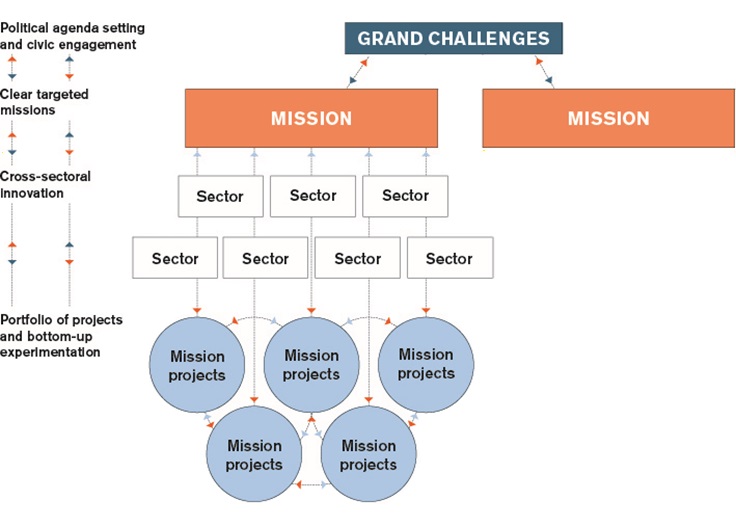
A challenge led recovery: the role of mission oriented industrial strategy
Governments are facing three types of crises around the world: the immediate one related to the health pandemic; a longer term one related to the previous financial crisis, with growth rates not fully recovered since 2008; and the climate crisis which is lingering on top of it all and putting the planet itself at risk. The inter-linked characteristics of these crises are defining the 21st century – and governments urgently need the capacity and tools to confront them head on. This is not only about the rate of growth, but its direction.
At the UCL Institute for Innovation and Public Purpose (IIPP), we have been advocating a “challenge-led” design to innovation and industrial policy. Achieving inclusive and sustainable growth requires not “levelling” but tilting the playing field so that key investments steer the economy towards its goals—such as those around a green transition— and certain economic behaviours are rewarded over others. Tilting is not about “picking” winners—whether these be sectors, technologies or types of firms. Rather, it is about picking societal problems and redesigning policy instruments, from grants to procurement, to allow the “willing” to solve those problems together.
In 2017-2018 as Special Advisor to the EC Commissioner for Innovation (Carlos Moedas), I wrote a report on the use of “mission oriented” policy to help direct research and innovation towards achieving societal missions or moon-shots. The basic idea, illustrated in the figure below, is that policy begins with an eye on key societal challenges such as those embodied in the 17 sustainable development goals, and then moves to designing missions that help catalyse investment and innovation across different sectors to tackle the challenge. This requires using government tools like prizes, grants, loans and procurement to nurture bottom up experimentation (the blue circles) required for mission completion. The process if of course not linear, and experimentation means trial and error and error—so the ability to also welcome risk taking and uncertainty is key to the ability of governments to ‘govern’ the mission oriented process. While the first report led to missions becoming a new legal instrument in Europe, in my second EC report on “governing missions” I focussed on the need for government instruments like procurement to be redesigned to drive bottom up experimentation.
Citing IIPP research in this area the government included four challenges in the 2017 Industrial Strategy: clean growth, future of mobility, healthy ageing and an AI-Data economy. At IIPP we hosted a commission on Mission Oriented Innovation and Industrial Strategy co-chaired by myself and David Willetts to help the government turn those challenges into clear missions. We spent a year working in collaboration with BEIS to develop a series of recommendations for how these missions could then be delivered. This included both thoughts about mission setting itself, as well as new dynamic indicators for policy evaluation. In a paper called Economics of Change, we argue that the moon landing would have never happened had it been evaluated along cost-benefit criteria.

Mission-oriented innovation does not replace the need to invest in and enhance the UK’s technological and sectoral innovation ecosystem, in fact achieving missions depends on these systems being in place. The Apollo Moon programme resulted in massive technology spill-overs, but without prior investment in rocket technology it wouldn’t have had much hope. Today, we shouldn’t advocate all of the UKs new R&D investment going towards missions, but conversely we can’t assume that only investment in R&D without the direction setting of government will achieve the spill-overs we’ve seen in the past.
COVID-19 makes this approach needed more than ever. Using our industrial strategy to stimulate innovation and investment towards solving key public challenges is a way to foster economic growth and develop new solutions for challenges being faced by citizens. These challenges include the obvious healthcare needs that the pandemic has thrown our way—from PPE, ventilators to the race for a vaccine—but also the challenges that the rapid adaptation to a lock-down society has exposed: the digital divide between children trying to access school classes online, loneliness of the elderly, the privacy of our data in mobile apps, and the meta-challenge of developing capacity across the public sphere.
We have long known that crises can spur governments to act in new and innovative ways – after all when countries go to war, no one asks how it will be paid for. In the same spirit governments have stepped up and worked in new ways to the challenges of COVID-19. In the UK, treasury estimate that support for the economy may run to almost £350 billion; the Japanese government recently announced more than $1 trillion of extra assistance for households and businesses; and the EU has a €750 billion plan.
But money alone is not enough. We need new ways of working across government and a policy approach that can be challenge led with a focus on inclusive and sustainable growth. A bold industrial strategy is key.
If the government wants to target the grand challenges in the Industrial Strategy – or in fact new challenges exposed by COVID-19 –it needs new policy tools, and new dynamic capabilities of the public sector. These should include the conventional R&D investment, but also linking it through to strategic procurement and the use of progressive regulations and standards setting to give directionality. In addition, the government needs new ways of working to deliver accountability and responsibility for missions or challenges across government, breaking down departmental siloes.
The government needs a clear strategy setting out which areas of the economy it wants to grow and how it will do so. There are some policies that can be adopted to strengthen both the industrial strategy and ‘grand challenge’ approach. Through the Treasury’s Future Fund, the government is now taking equity stakes in high-risk high-potential start-up firms meaning they can share in the rewards of the successful companies they have supported in the riskiest phase of development. This should be adopted more widely to recognise the state’s role in supporting innovation.
There is also a need to look to strengthen the institutions that are required to support this approach. There is much to learn from the US Defence Advanced Research Projects Agency (DARPA) both in healthcare and grand challenges more broadly. In my 2013 book The Entrepreneurial State: debunking public vs. private sector myths, I showed how DARPA was responsible for lots of the innovation that makes a smartphone smart, and in 2018 at IIPP we advocated new DARPA-style organisations in the health sector. In 2020, the UK government has committed to setting up a DARPA-organisation but this must be grounded in what really made DARPA work in the US, and the specifics of the UK case. It should be focussed on transformational application, development, scaling and deployment of existing technologies. In the US DARPA has the benefit of being able to leverage military procurement to “pull through” innovation – how can we do this in the UK? And what are the UK’s strategic priority areas, like renewable energy, where transformational innovations are needed.
Challenge oriented policies require leadership and government departments to work together to make it happen. The COVID-19 crisis needs that leadership more than ever. Going “back to normal” won’t work, if normal (business as usual) is part of the problem. We must take advantage and build a stronger, more innovation-led, inclusive, and sustainable economy. Missions can help make that happen.